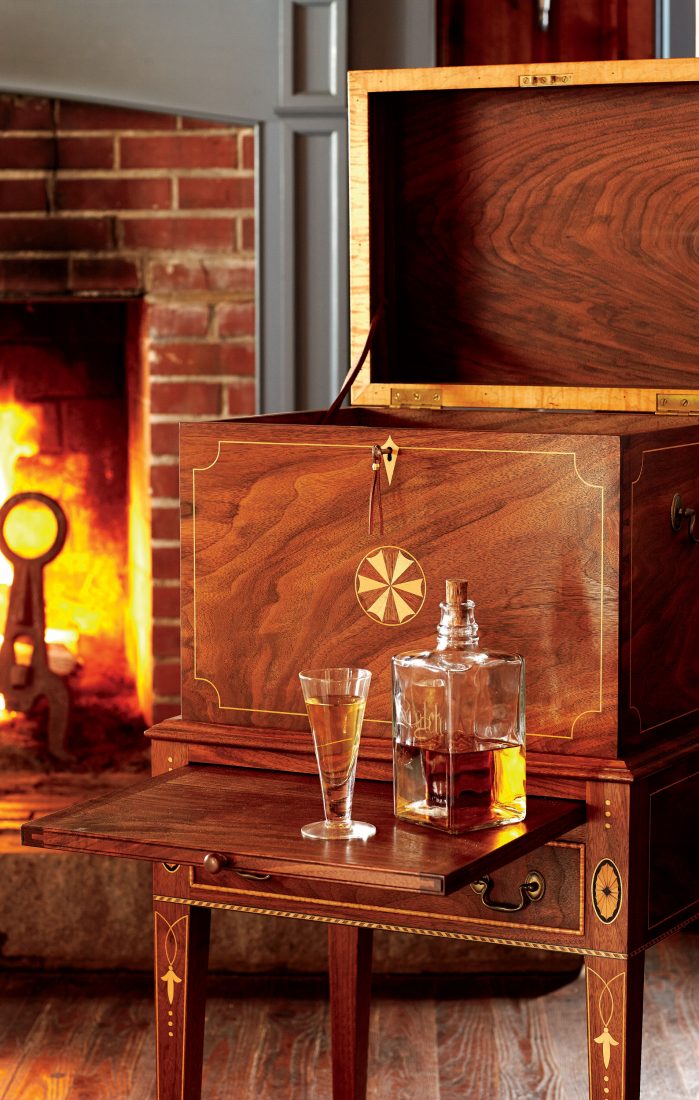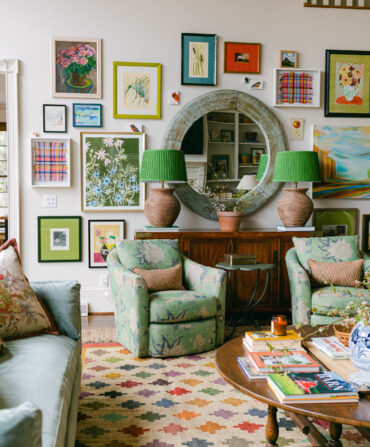In a sawdust-scented workshop triangulated by roadside peach stands, on a quiet South Carolina highway in the outer orbit of Charlotte, a father and son are building small and lasting monuments to a timeless truth: In drinking, as in other vital concerns, style matters. Their crafted-to-order, heirloom-grade cellarets—lidded wooden liquor cases with slide-out mixing boards and partitions to hold bottles, fitted onto tall-legged stands—are a reverent nod to early Southern history. They’re also a surefire way to elevate cocktail hour.
“A lot of people, even Southerners, have never seen one, never heard of one, even though it’s the quintessential Southern furniture,” says John Leake, the sixty-year-old, white-bearded proprietor of Leake Furniture Makers, on the outskirts of the leafy country town of York. With his son Jay, who is thirty-three, he makes riveting period reproductions of distinctively Southern furnishings. They build grand Charleston-style poster beds with seven-foot mahogany poles, as well as sideboards, farm tables and matching chairs, chests of drawers, highboys, and secretaries. But the cellaret, John confesses, “is one of our favorite pieces, because it’s so indicative of the South.” “You weren’t a true Southern gentleman,” adds Jay, “unless you had a well-stocked cellaret.”
Also known as bottle cases, brandy cases, or gin cases, the cellarets that the Leakes are re-creating originated in the 1700s in the Southern colonies, especially coastal Maryland, the Roanoke River basin of Virginia and eastern North Carolina, and the Piedmont of both North and South Carolina, and remained popular into the early nineteenth century. They marked the confluence of two currents: planters’ wealth, and the abundant flow of alcohol—rum from the Caribbean and the Carolinas, homemade cider and ale, European wine—that lubricated their gatherings. They combined storage and showmanship. “Cellarets were at the center of an elaborate range of domestic objects,” wrote Daniel Kurt Ackermann, a curator at the Museum of Early Southern Decorative Arts, in Winston-Salem, North Carolina, “that transformed drinking from an act of hydration to one of performance.”
With that heritage always in mind, the Leakes build a single piece at a time, just the two of them, unrushed and paying painstaking attention to the minutest of details. “You can hardly improve on the timeless eighteenth-century design” of a cellaret, says John, whose father and grandfather sold antiques at this same location. “But we can improve on the construction techniques a little bit.” A single cellaret is likely to take them three labor-intensive weeks to complete. After discussing details with a client, they carefully choose the precise boards—always walnut, in keeping with tradition—perhaps spending an entire day scrutinizing lumber to find a plank with just the right eye-catching grain, just the right goldish, reddish-brown hue. They use no plywood, no veneers, no CAD drawings, no preprinted plans. They hand cut dovetails for the fifteen-inch-cube case, sturdy the bases with pinned double-mortise-and-tenon joints, fit the lid, nearly an inch thick, in a floating, tongue-and-groove style to allow the wood to shrink and swell with the seasons without cracking. They may add ornamental inlay to the case, or tiger maple cock beading to the drawer. They finish the wood with boiled linseed oil (to bring out the color over the years to come) and shellac, fasten it with solid-brass hardware from Connecticut, museum-quality locks made in England, and bridle leather straps from Montana for the lid—all of it designed to wear well and age gracefully. “The worst the piece ever looks,” John says, “is the day we complete it.”

Photo: Brie Williams
The essentials inside the cellaret.
And there’s something else that makes each cellaret special. The Leakes never build one on spec, or in a vacuum. They build each bottle case for a specific customer, someone they’ve met and spoken to and perhaps had a drink with. They work with only twelve to fifteen clients a year, and handle the entire process themselves, from unloading lumber off the truck to delivering the finished piece. It’s old-fashioned craftsmanship, handled in an old-fashioned, person-to-person manner, centered around an old-fashioned pleasure. And when it comes time for the “ceremonial unveiling” for the client, there’s one last finishing touch: “We try to include a bottle of something they like,” John says, “as a starter kit.”









